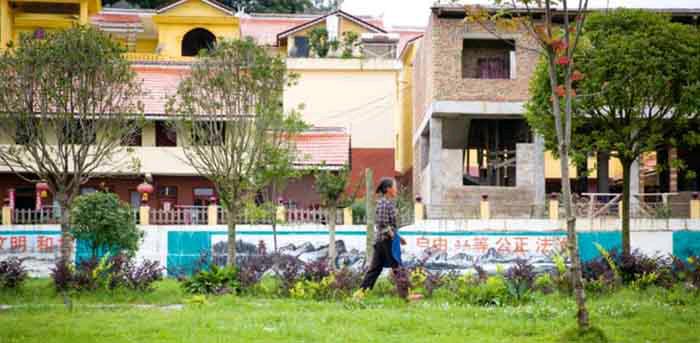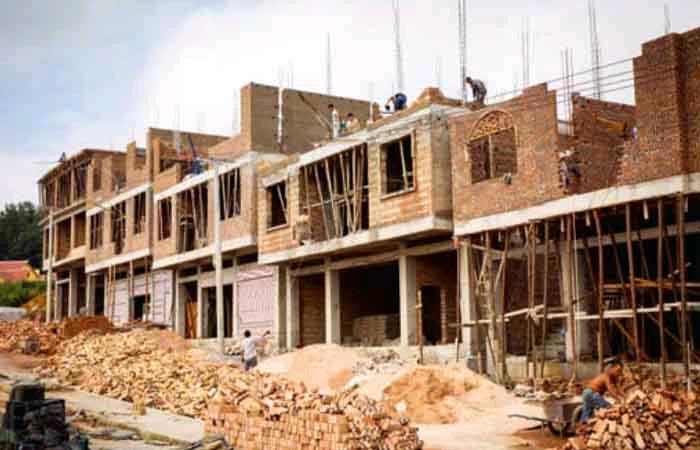Tangyue:Prosperity from Adversity
by+Li+Zhuoxi
Tangyue Village in Anshun city, Guizhou Province was once a typical poor village in Chinas mountainous areas: Around 800 acres of its land is fragmented, and farmers subsist on traditional agriculture. Among the 1400 working-age residents of the village, nearly 900 leave the city every year to find work. Thirty percent of the village is wasteland.
In June and July of 2014, two rainstorms hit the village and almost every house and field was swallowed by the rising current, rubbing salt into the wounds of the dilapidated village.
“Nothing is difficult under the guidance of party cadres”
The floods forced the impoverished village into despair.
“My house was flooded 3 years ago,” recounts 82-year-old Zhu Shunhua. “The waist-deep water washed all of our crops and food away. I didnt know how I could go on living.”
With an already-poor village decimated by natural disaster, what could be done? “From adversity to prosperity, we have come to a key crossroads for change,” declared the villages party secretary Zuo Wenxue, proposing transformative change without turning back.
Shortly after election of the village committee and Party branch members, with support and leadership of the higher Party committee, the village decided to use the urgent need to save the village as an opportunity to bring people together and promote joint development.
The day after the disaster, Anshun municipal Party committee secretary Zhou Jiankun arrived. Thanks to his inspiration, Zuo decided to guide everyone in setting up cooperatives, and unite all assigned responsibility cropland with unified management to realize industrial-scale development.
“Nothing is too difficult with the guidance of party cadres,” said Zhu on the changes that took place afterwards. “I never expected Tangyue Village to become such a well-off place in my lifetime.”
As Zuo said, “Choose a road, build a team, train the team, adopt a set of policies, and great changes will take place.”
“Uniting the village for joint ventures”
Land issuance became the focus of discussion among villagers during post-disaster reconstruction. “We cannot go on with our current fields, so why not find a company to contract the village land, so the younger residents can travel outside to work?” asked some villagers. However, others opposed the idea: “Migrant work does not last long. After that, we must come back. Furthermore, if only old people and children are left in the village, is it still a village?”endprint
Zuo knew that Tangyue, like many villages, faces rural hollowing, an aging population and decreasing agricultural labor quality. Meager production failed to respond to myriad changes in the big market. This was why the village was having such a hard time shaking off poverty. Only when farmers became united and managed across a large patch of land could they maintain a stable wage.
The Tangyue Village Committee and Party branch found basis for reform in the resolution of the Communist Party of China in the third Plenary Session of the 18th CPC Central Committee, and decided to launch the “golden land” cooperative and the land transfer center.
This move marked a risky turning point for the entire village. Farmers retained the right to contract land and transferred usage rights to cooperatives. Previously, Tangyue Village mainly planted potatoes and corn, which did not produce great economic benefits. After the establishment of the golden land cooperatives, planting income increased by simply adjusting the planting structure and planting vegetables on the transferred land.
In just three years, 90 percent of farmers in the village had joined the cooperative. The cooperative united around 700 acres of land that produced crisp red plums and lotus roots, and a pheasant breeding industry was developed. About 30 percent of income was distributed to the cooperative, 30 percent to the village collective and 40 percent to the villagers.
Villager Zhang Fuyou, 54, revealed that his half an acre of land is now all shared by the cooperative. Efficient usage of land resources to maximize profits greatly multiplied their previous land income. In previous days, Zhangs family were all migrant workers, and the land was left uncultivated. Little was saved from their humble earnings. Now with the development of cooperatives, the familys annual income has reached 50,000 yuan (around US$7,500), and they found the money to build a three-story house
“Uniting the village community for joint ventures” is also great motivation for migrant workers to return home. Peng Yanquan, who works in the cooperative transport team said, “I used to receive frequent calls from bosses asking me to go back to work. I told them our village is under construction, and we have work and income all year round. Furthermore, we can take care of the elderly. There is no place like home." endprint
endprint
In 2015, 70 percent of the village land had been transferred to cooperative shares, and by 2016, every villager was a shareholder of the cooperative. This has provided important land resources and the manpower for scaled agricultural management and adjusting planting structure.
Changes in Tangyue Village are even significant in the form of data: in 2014, the number of migrant workers from the village was 860, a figure which dropped to 50 in 2016. The population in poverty fell from 643 in 2014 to zero in 2016. In 2014, the village collective economy produced less than 40,000 yuan (around US$6,000), and in 2016 it soared to 2.024 million yuan (around US$300,000). The 2014 per capita income was 3786 yuan (around US$568) compared to 10,030 yuan (around US$1,504) in 2016.
“Nine Red Rules” and Village Self-Governance
Another characteristic of “uniting the village for joint ventures” has been the simultaneous development of economic construction and grass-roots governance.
A resolution passed at a meeting of village representatives defined the unique “nine red rules” that regulate the health system, banquet system, loans and rules for respecting the old and cherishing the young. The formulation and implementation of rules effectively solved decades accumulation of corrupt customs. More importantly, the relationship between villagers, and between villagers and the collective, has been effectively and rationally constructed to maximize development potential.
To ensure that every Party member in the village serves as an exemplary role model, villagers regularly score Party members. Members who score less than 60 points on three consecutive appraisals are asked to resign from the Party. This mode is used to assess whether the party really plays an exemplary role, and with it, Party construction in the village has run smoothly, and Party membership has increased rapidly.
The village autonomy in Tangyue has not only formulated an effective method to incorporate the Party branch in village governance, but also solved management problems. It combined the leadership of the Communist Party and traditional Chinese village governance while providing experience for the exploration of village and Party cooperation in the process of urbanization.endprint
China Pictorial2017年10期
